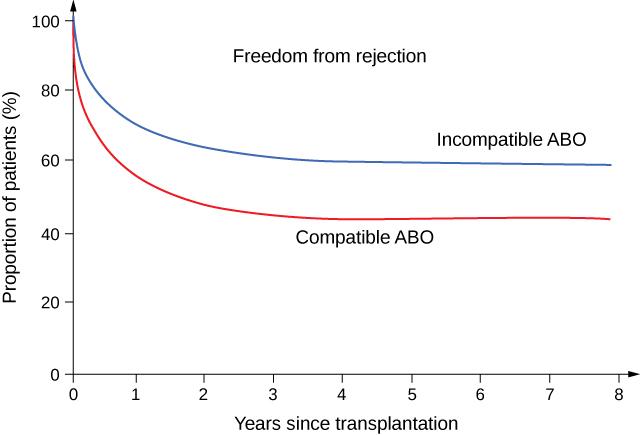Science Practice Challenge Questions
31.1 Overview of the Circulatory System
Like Gram-positive bacteria, red blood cells have carbohydrates on the cell surface. The A, B, A/B, and O blood types are designations of the phenotypes expressed by the alleles that code for these cell surface carbohydrates.
- Describe the relationship between regulation of expression and the differences among the A, B, A/B, and O types of blood cells.
- Explain how the blood group phenotype does not display non-Mendelian inheritance, and describe the simplest alternative model that explains this deviation.
Immune system T-cells recognize cell surface carbohydrates of bacterial and red blood cells. That these similarities have consequences for survival is indicated by the observation that individuals with blood type O are more susceptible to infection by Vibrio, the Gram-negative bacterium that causes cholera; in contrast, individuals with type A/B are more susceptible to infections from a broad range of E. coli variants, all of which are also Gram-negative.
- Describe the likely reason for the increased susceptibility of individuals with type A/B blood in terms of the antigen-antibody model of specific immune response. Justify the selection of data that would allow a test of your reasoning.
- The distribution of blood types is determined in a population. The results are displayed in the table. Fill in the frequency of each genotype. Don’t forget that the total should add up to 1.00 (100 percent).
Type Observed Frequency A 501 B 794 A/B 236 O 601 Total, N 2,042 Recall that the frequency of an allele can be determined if the genotype is known. If we take an example of a gene with two possible alleles, of which one is dominant and one is recessive, we need to calculate the number of each allele and divide by the total number of alleles (not genotypes). For example, let’s say that you have 50 homozygous dominant individuals and 50 homozygous recessive individuals. That means that you have 100 dominant alleles (two per homozygous dominant individual) and 100 recessive alleles (two per homozygous recessive individuals) and a total of 200 alleles. The frequency of the dominant allele is 100/200 = 0.5.- Using the observed numbers of each genotype in the table, calculate the frequency of each allele as described above. Don’t forget that the total should add up to 1.00 (100 percent of the alleles).
Genotype Observed Frequency IAIA 320 IAio 181 IBIB 349 IBio 445 IAIB 236 ii 601 Total, N 2,132 Allele Probability A B O - Using these probabilities, calculate the expected frequencies (E) of each blood type using the Hardy-Weinberg equation for three alleles given below.
p = frequency of IA
q = frequency of IB
r = frequency of i
p2 + 2pq + q2 + 2pr + 2qr + r2
Use the information in the table above to calculate expected numbers to add to this table.Genotype Symbol Frequency/Total individuals IAIA p2 0.061/131 IAIB 2pq 0.160/342 IBIB q2 0.104/222 IAi 2pr 0.213/454 IBi 2qr 0.277/591 ii r2 0.184/392 Type Observed, O Expected Frequency, E A 501 B 794 A/B 236 O 601 - Apply your understanding of the conceptual foundation of these equations by restating in words the relationship represented by E(A).
- Apply a χ2 test at the 95 percent confidence level and 3 degrees of freedom (number of traits minus one) to evaluate the claim that these data indicate Hardy-Weinberg equilibrium of the ABO system for this population. The definition of the statistic is provided on the AP Biology Exam.
This table is also provided on the AP Biology Exam.
Degrees of Freedomp 1 2 3 4 5 6 7 8 0.05 3.84 5.99 7.82 9.49 11.07 12.59 14.07 15.51 0.01 6.64 9.32 11.34 13.28 15.09 16.81 18.48 20.09 - Hardy-Weinberg equilibrium is consistent with the assumption of no change in the distribution of alleles over time. Justify the selection of data that should be obtained to further test this assumption. Homologous genes coding for the carbohydrates that are present on the surfaces of red blood cells are found in amphibians and mammals but not in fish, implying a last common ancestor for the ABO gene system at least 20 million years ago.
Homologous genes coding for the carbohydrates that are presented on the surfaces of red blood cells are found in amphibians and mammals but not in fish, implying a last common ancestor for the ABO gene system at least 20 million years ago.
- Using the observed numbers of each genotype in the table, calculate the frequency of each allele as described above. Don’t forget that the total should add up to 1.00 (100 percent of the alleles).
- The difference between genes coding for A and B is a single nucleotide replacement. Evaluate the likelihood that negative selection pressures have been active in the evolution of this system.
31.2 Components of the Blood
The immune system rejection of transplanted organs and the availability of organ donors are key factors in determining survival. Blood ABO compatibility is always a criterion in matching donors and recipients in adult patients and was once a consideration for infant patients. Period of time on the waitlist for a suitable donor is critical because the health of the patient degrades while waiting. Dipchand et al (American Journal of Transplantation, 10, 2010) made a comparison of survival rates for infants where the donor heart was ABO compatible and incompatible as shown in the graph.
Based on these data, justify the claim that expression of blood group immune response develops over time and that this provides a window of opportunity for transplantation.
